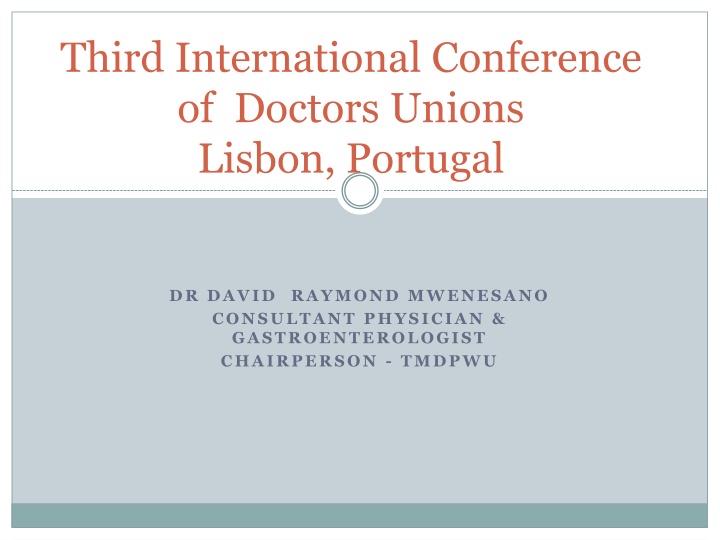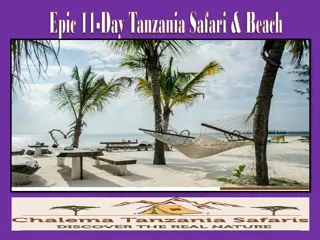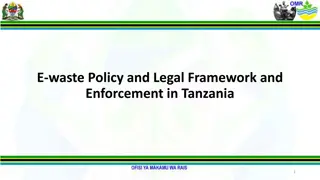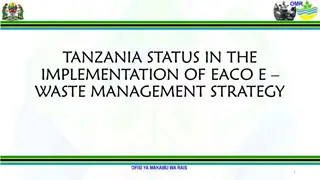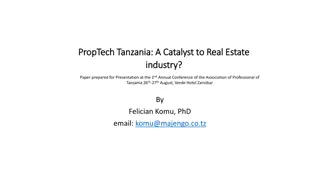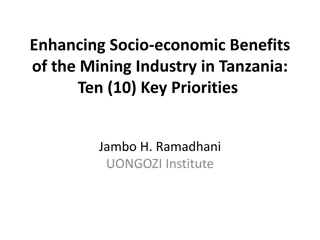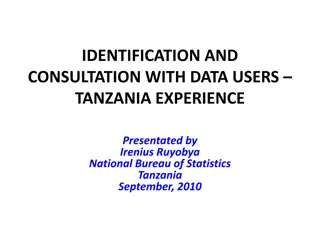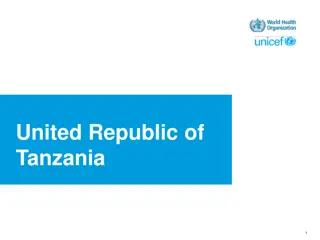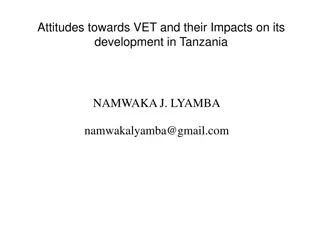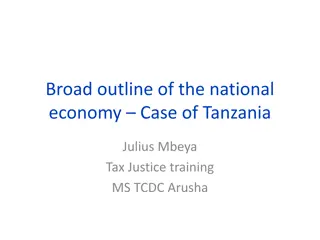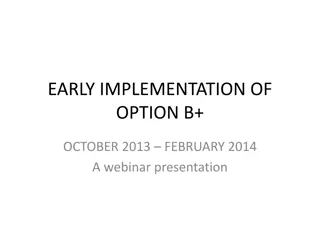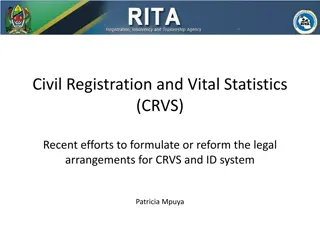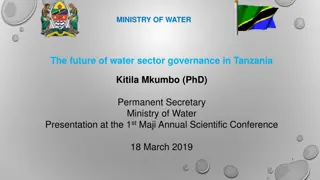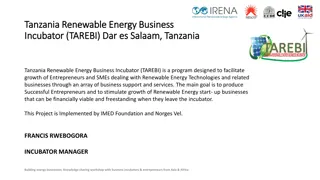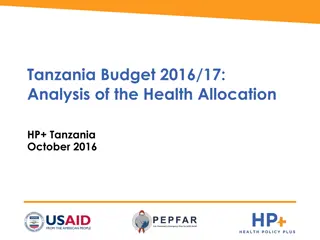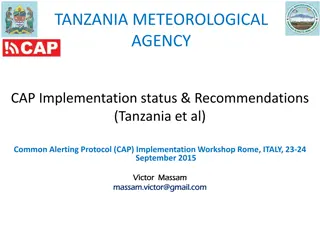Health Sector Overview in Tanzania: Challenges and Vision for 2025
Tanzania faces significant health challenges with a population of 55 million, low GDP per capita, and high disease burden. The country's Vision 2025 aims for a high quality of life, good governance, and a competitive economy. The United Nations Sustainable Development Goals emphasize the importance of ensuring healthy lives for all. The health sector in Tanzania plays a crucial role in achieving these objectives.
Download Presentation

Please find below an Image/Link to download the presentation.
The content on the website is provided AS IS for your information and personal use only. It may not be sold, licensed, or shared on other websites without obtaining consent from the author.If you encounter any issues during the download, it is possible that the publisher has removed the file from their server.
You are allowed to download the files provided on this website for personal or commercial use, subject to the condition that they are used lawfully. All files are the property of their respective owners.
The content on the website is provided AS IS for your information and personal use only. It may not be sold, licensed, or shared on other websites without obtaining consent from the author.
E N D
Presentation Transcript
Third International Conference of Doctors Unions Lisbon, Portugal DR DAVID RAYMOND MWENESANO CONSULTANT PHYSICIAN & GASTROENTEROLOGIST CHAIRPERSON - TMDPWU
INTRODUCTION HEALTH STATISTICS HEALTH FINANCING TANZANIA VISION 2025 UN SUSTAINABLE DEVELOPMENT GOALS & MDGs DOCTORS IMMIGRATION, WORKING TIME & RESIDENCE PROGRAM IN TANZANNIA CONCLUSION
INTRODUCTION The United Republic of Tanzania is the largest country in East Africa, covering 940,000 square kilometres, 60,000 of which are inland water. Tanzania lies south of the equator and shares borders with eight countries: Kenya and Uganda to the North; Rwanda, Burundi, the Democratic Republic of Congo, and Zambia to the West; and Malawi and Mozambique to the South.
INTRODUCTION Tanzania has a population of 55 million The life expectancy is at 62 yrs on average GDP per capita (current USD, 2014) $955 Income classification Low High burden of disease remains a major challenge facing the health sector
VISION 2025 Tanzania Vision 2025 provides direction and a philosophy for long-term development Tanzania wants to achieve by 2025 a high quality of livelihood for its citizens; peace, stability, and unity; good governance; a well-educated society; and a competitive economy capable of producing sustainable growth and shared benefits The health has been identified as one of the priority sectors contributing to a higher quality of livelihood for all Tanzanians
UN SDGs: Health number3 TO ENSURE HEALTHY LIVES AND PROMOTE WELL-BEING FOR ALL AT ALL AGES Importance of good health Our health affects everything from how much we enjoy life to what work we can perform. The goal is to make sure everyone has health coverage and access to safe and effective medicines and vaccines We have the means to turn that around and make good health more than just a wish
Health Statistics in Tanzania Life expectancy = 62years Infant mortality rate = 25 (32)target was 19/1000 live birth by 2015 To reduce under -5 mortality from 112 to 54 deaths per 1,000 live births Children immunization > 97 Contraceptives use = 32% MMR = 556(587) target was 193 /100,000 by 2015 To increase coverage of emergency obstetric care from 64% to 100% of hospitals and basic comprehensive emergency obstetric care services from 5 % to 70% of health centres and dispensaries
HIV PREVALENCE IN TANZANIA HIV prevalence is at 5,6% from 10% at the beginning of New Millennium UNAIDS = 90 90 90 Improve HIV/AIDS testing = 73% ARV coverage = 98% Viral suppression = 83%
Health Financing in Tanzania Per capita, government expenditure on health has increased slowly, up to US$49 in 2013, which compares favorably to other countries in the region. At 7.3%, Tanzania's spending as a percentage of gross domestic product (GDP) on health is higher than the average of 5.3% in other low-income countries (LICs) Abuja Declaration proposed use of atleast
Who contributes for HF in Tanzania? Tanzania s health financing system is dominated by tax- and donor -funded health delivery, with a modest proportion of the population enrolled in social, community, or private health insurance The remaining population, reflecting the still -large proportion of people working in the informal sector or the ver y poor, is dependent on the public sector; they neither have insurance nor are served by any other sustainable mechanism(Out of pocket/ cost sharing/ Exemption)
Who contributes for HF in Tanzania? Current insurance coverage is modest, at 25.8% of the population The National Health Insurance Fund (NHIF) is the largest scheme as defined by premiums collected (US$148.6 million in 2014), and the Community Health Fund (CHF) has the most beneficiaries (8.2 million people by January 2016) The private health insurance sector covers only 1.4% of the population
Is there any plan for the HF? The mission of the Health Financing Strategy is to establish a comprehensive social health protection system for all Tanzanians National health financing strategy (HFS), has laid out draft in which by 2020 at least 70% of Tanzanian population should be covered by NHIF under the Universal Health Coverage .
Is there any plan for the HF? If this legislation passes, UHC will eventually be mandatory, resulting in increased revenue and risk sharing This type of mechanism can reduce the burden on the government s health budget and allow the GOT to concentrate its resources on provisions for vulnerable, low -income groups that cannot afford to pay
NUMBER OF DOCTORS DISTRIBUTIONS IN TANZANIA The WHO estimated Tz as having a doctor to population ratio of 0.02 physicians per 1,000 population in 2006 (WHO2006)which has improved to about 0.05 physician per 1,000 population in 2011 (MOHSW,2012)
Current status of MDs in TZ 42.8% of graduate doctors are working full time in hospitals & 15.5% are pursuing further studies 13.7% work in NGOs, 11.9% are working in health training or research institutions and others (16.1%) are either working in non-health businesses, MOHSW/health related firms or are suspended
Current status of MDs in TZ Tanzania need 197,932 doctors in all cadres General practitioners and Specialists to cater for the whole Nation of 55 million population BUT 90873 Doctors present currently
Causes of migration Medical doctors leaving Tanzania because of both push and pull factors Pull factors include better remuneration and working environment, job satisfaction, and prospects for further education Push factors include lack of education opportunities, poor working environment, poor infrastructure, and lack of diagnostic equipment
Migration of Doctors Tanzania Perspective Doctors and other health professionals migrating from Tanzania to developed countries Others migrate from Tanzania to other African countries such as South Africa, Botswana , Namibia etc.
Migration of Doctors Tanzania Perspective The chronic under-investment in public sector healthcare systems is a major contributing factors to this migration and the health crisis in the country
Effect of migration This migration creates unfortunate imbalances in the global health workforce and hence impact on negative health services provision This movement of medical doctors leaves the country not only with a shortage of medical professionals, but also increased morbidity and mortality
Effect of migration By 2006, Tanzania, with a population of 40 million, had only 1,264 doctors working in the country and 1,356 doctors working abroad Tanzania was needed to triple its number of doctors if it was to achieve the MDGs of reducing child mortality and improving maternal health Ten years now since the report was out situation is still same yet the country need to achieve SDGs
Effect of migration Tanzania, pays for some of its medical students to attend college in 2 different ways Those who excelled in their advanced level education can receive full scholarships
Effect of migration Some students receive no interest loans of various amounts, depending on need These investments become economic losses if the students decide to leave the country and work elsewhere
The Tanzanian government spends US$27,256 to train each medical student from primary school through medical school It is estimated that Tanzania has spent US$3.5 million training Tanzanian-born doctors who are currently practicing in Australia, Canada, the UK, and the US (Mills et al. 2011)
Effort to Curb Migration In order to curb this trend government of Tanzania has put in place incentives to retain doctors in the country Improving financial and non-financial incentives, work conditions and availability of medical supplies and equipment. 1. It allows doctors to have intramural private practice within the public hospitals in which Doctors gets 30% of consultation and the procedure if done 2. It increases salaries of medical doctors now a GP in public hospital gets around 1000USD gross and Senior Specialist around 1804 USD gross before taxes.
Effort to Curb Migration 3. It provide tax exemptions on vehicle imported by medical doctors after every 5years. 4. Medical doctors are entitled to grade A housing if is not available then they get housing allowance which is equivalent to 30% of their salaries. 5. It provides On-call allowances of 10USD per call 6 . It gives 100% grants to medical doctors who wants to specialize
Doctors Migrations Nonetheless, large numbers of Tanzania -trained physicians leave home upon completion of their medical school training in search of careers in higher-income countries They leave behind health system that is severely stressed
Doctors Migration While health improvements in Tanzania will require a broad agenda of development activities, access to an educated workforce of health professionals is also essential
Doctors Migration There is a need to ensure the individual migration rights of health professionals do not compromise societal population rights to health There are also should be a public and fair agreements between countries within an internationally agreed framework how to handle this problem
DOCTORS WORKING TIME Tanzania working time according to Government Standing order of 2009 is 8hrs per day and 48hrs per week However due to shortage of staff most of the time doctors find themselves working more than what is required by standing order. Normally a doctor is supposed to get into work by 8am in which is supposed to do ward round, attend clinics or perform procedures Sometimes clinics extend up to 7pm in public hospitals
DOCTORS WORKING TIME There are doctors who are on call for 12hrs after normal working hours this was supposed to be paid about 12 USD per call, but despite it being very low is not paid on regular basis sometimes it can take up to 2years before payment
DOCTORS WORKING TIME Due to congestions in most public hospitals many hospitals have introduced compulsory Saturday clinics in which Doctors see patients under Intramural Private Practice in which a doctor see a patient in the Public hospital and is paid 60% of the consultation fee. Doctors working time in my country does not follow any International standard
DOCTORS WORKING TIME Due to these problem we have seen several protests from Doctors e.g In 1992, 2005 and 2012 All these major protests doctors put tools down they shut even emergency services in the country wide Government was forced to sit down and discuss with Doctors representatives to end the boycott
In 2011 Medical Association of Tanzania(MAT) called a meeting to discuss doctors welfare and working time for doctors and in that meeting we were told according to Tanzanian law MAT is not registered as Trade Union so Trade Union was formed TMDPWU but Government refused to register this trade union due to fear that when doctors are united it will be difficulty to contain them
Then the biggest strike came in 2012 all public hospitals and some private hospitals supported the strike during the process of negotiation MAT refused to negotiate on behalf of the doctors due to the same reason which was given by the government that it not registered as Trade Union Then government agreed to register TMDPWU in 2013 TMDPWU has a mandate to negotiate with government, before that there was a government leaned Trade union which claimed to represent doctors in the country
RESIDENCE PROGRAMS Tanzania started producing clinical officers and Assistant Medical Officers after independence 1963 in the Faculty of Medicine, Dar es Salaam University College of the University of East Africa In 1970 it became Faculty of Medicine, University of Dar es Salaam (UDSM) and the same year 1970, the Faculty of Medicine (FOM) soon initiated its first degree, the Doctor of Medicine (MD) programme
Medical Universities in Tanzania Muhimbili University of Health and Allied Sciences (MUHAS) 1963 Kilimanjaro Christian Medical Centre (KCMC) 1997 Hubert Kairuki Memorial University (HKMU) International Medical and Technology University(IMTU) Bugando Medical University University of Dodoma (UDOM) St. Joseph Medical University St. Francis Medical University
RESIDENCE PROGRAMS Tanzania residence programs started during 1980 and it was structured to provide general medical specializations until 2011 when we started super specialization courses. Residence program follows 5years of intensive training in medical school which followed by 1 year of internship in the hospital For those who need government support then you need to work in the public hospital at least 2years
Residence programs Normally residence program is conducted by university hospitals so you need to be admitted in the University first and it can take 3 or 4 years depending on the program and University Normally residence program are intensive training of lectures, journal clubs, Grand round/ symposium, dissertations submission and bed side clinical teaching and clinical examinations
Residence programs During residence program resident normally work beyond the required time by law There is little pay or sometimes no payment at all No leave only gets 14days off during university closure If you get leave then not paid leave the reason is you are on training
Residence programs Unfriendly environment especially from supervisors and lecturers To address all these several measures have been put in to the place including starting Postgraduate Diploma in Education for aspiring medical lecturers Reduction of working hours for residents by involving more medical specialists on duties
